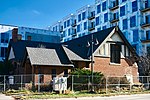New Pioneer Food Co-op
New Pioneer Food Co-op, commonly shortened to New Pi, is a locally owned food cooperative based in Iowa City, Iowa. This city also serves as the headquarters of the National Cooperative Grocers Association. New Pioneer has stores in Iowa City, Coralville, and Cedar Rapids as well as a production hub in North Liberty, Iowa. New Pioneer was founded in 1971 as a natural foods buying club modeled after the Rochdale Principles, and is now a full-service bakery, deli, and grocery store. It specializes in local food, organic produce, cage-free antibiotic and hormone-free meat, milk, and poultry. The co-op's seafood program is certified sustainable by the Seafood Watch program from the Monterey Bay Aquarium. The handmade pastry selection uses local cage-free eggs, local butter, and organic flour, and also offers a selection of wheat-free dessert options. All foods sold are restricted to natural additives. The co-op offers eco-friendly home and healthcare products.New Pioneer takes its name from the organization that created the cooperative model, the Rochdale Pioneers.
Excerpt from the Wikipedia article New Pioneer Food Co-op (License: CC BY-SA 3.0, Authors).New Pioneer Food Co-op
South Van Buren Street, Iowa City
Geographical coordinates (GPS) Address External links Nearby Places Show on map
Geographical coordinates (GPS)
| Latitude | Longitude |
|---|---|
| N 41.660319444444 ° | E -91.528561111111 ° |
Address
New Pioneer Food Co-op
South Van Buren Street
52240 Iowa City
Iowa, United States
Open on Google Maps










